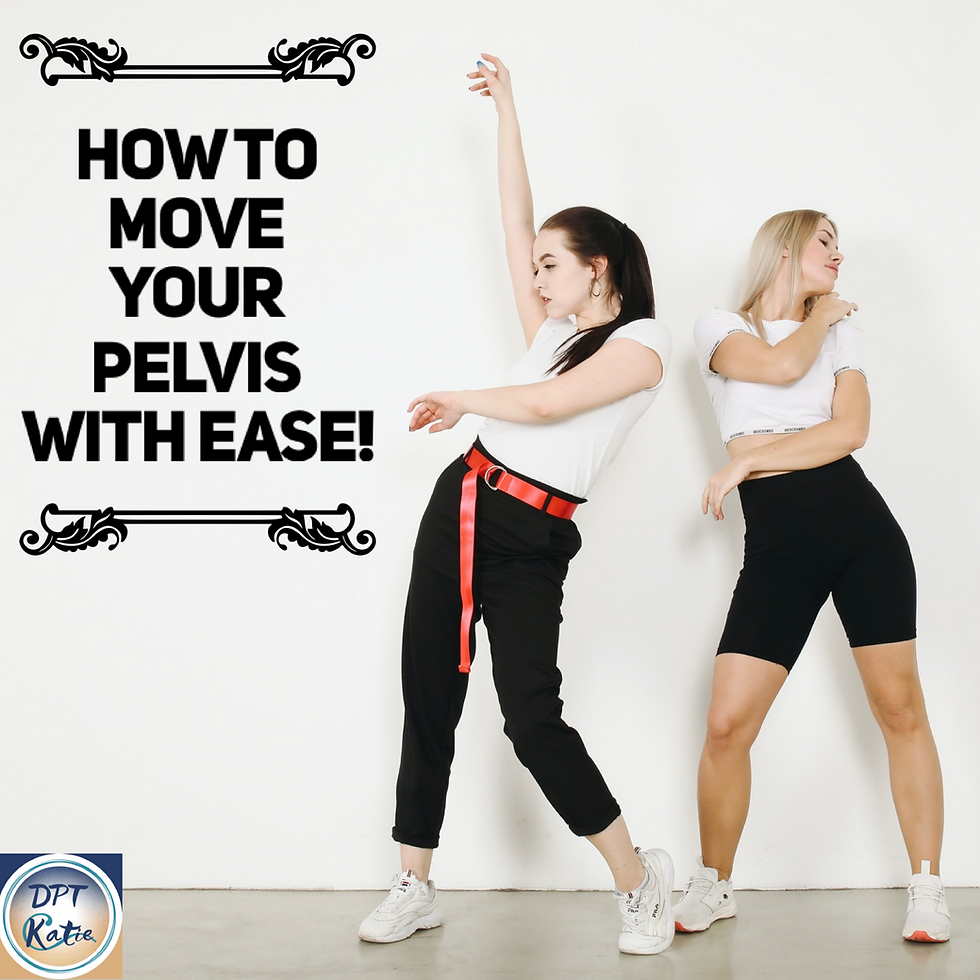How to Move Your Pelvis with Ease
- Katie van den Heuvel
- Aug 26, 2021
- 3 min read
Updated: Aug 27, 2021

Getting your pelvis to move with ease and fluidity takes preparation, practice, and patience. One of the most important things you can do to help this process along is to incorporate some simple stretches into your routine. Today we’re going to focus on some stretches you can do for your quadratus lumborum (QL), low back, and abdominal muscles. All of these muscle groups are integral to creating free movement in your pelvis and hips while dancing. With each of the suggested exercises below you can complete dynamic repeated stretching as part of a warm up or static sustained stretching following activity as part of a cool down or focused mobility session. I've even made a YouTube video for you! Questions on sets and reps? Book a free video chat with me to discuss your own needs and goals!
1) Stretching the Abdominal Muscles
It's important to understand how your core works when you dance. When a person moves their pelvis, they need to use their abdominal muscles and low back in order for it to move with ease. Of course, these muscles must be strengthened to improve your control. If you don't take some time to also let these muscles stretch, then over time you may find it harder and harder to move your pelvis freely, since these body parts will be tight and more prone to injury. Be sure that when doing any dance exercise or routine where you are strengthening, you're also stretching to maintain mobility.
Cobra:
Begin lying face down with legs straight behind you. Place your hands next to your chest on the floor. Push your hands into the floor and lift your chest off the floor until you feel a stretch, straightening your elbows. Keep your pelvis down on the floor. Gaze forward. Return to lying on your belly.
Extension over a swiss ball:
Begin lying with your back resting on a swiss ball and your feet resting on the ground. Clasp both hands behind your head, then stretch backwards over the ball, and hold. You should feel a stretch in your chest and abdominals.
2) Stretching the Low Back
One of the most common places for a dancer to feel tightness is in their low back. This can be due to some improper alignment while dancing, or simply from spending a lot of time sitting down the rest of the day. It's definitely important for all dancers (and even non-dancers) to engage in some sort of routine low back stretching.
Supine Double Knee to Chest:
Begin lying on your back with your knees bent and feet resting flat on the floor. Using your hands, slowly pull your knees toward your chest until you feel a gentle stretch in your lower back. Make sure to keep your back relaxed during the stretch.
Seated bend over:
Begin sitting in a chair with your feet on the ground, shoulder width apart.Bend forward as far as you can, letting your arms hang toward the floor. Make sure to keep your back relaxed during the stretch.
3) Stretching the Quadratus Lumborum
If you’re having trouble moving your pelvis from side to side when you dance, it may be because of tight quadratus lumborum muscles. These muscles run from your lower rib cage to your pelvis through the side of your waist and are responsible for helping you side bend, back bend, and hip hike—so if they’re tight, you won’t be able to move freely, particularly with with hip circles and drops.
Childs pose with side bending:
Begin on all fours. Sit your hips back as you reach your hands forward and to the side, then continue to sink further into the stretch. Hold, then repeat to the other side.
Supine Quadratus Lumborum Stretch:
Begin lying on your back with your knees bent and feet flat on the floor. Cross one leg over the other. Let both of your knees fall to the side of your bottom leg (think of using the top leg to pull the bottom leg over to the side), then reach your arm out to your opposite side and hold when you feel a stretch in the side of your low back. Make sure to keep your shoulders flat on the ground during the exercise.
Watch the video with all the stretches here!








Comments